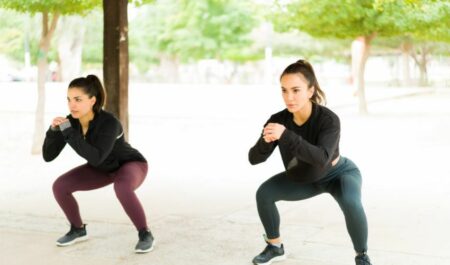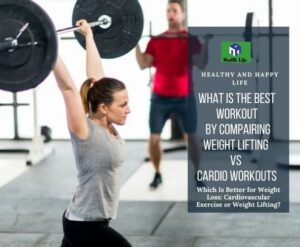Many people who have made the decision to lose weight are faced with the difficult choice of whether they should engage in cardiovascular exercise or strength training. Although these are the two most common kinds of exercises, it might be difficult to determine which one makes more efficient use of your time. This article will provide you with all the information you want on the benefits of weight lifting vs cardio exercise for weight loss.
What Is Cardio?
Cardio, short for cardiovascular, refers to the cardiovascular system, which comprises the heart, blood vessels, and blood. The term “cardio” is often used as a shorthand way of referring to cardiovascular exercises or aerobic exercises, which are activities that elevate your heart rate and increase oxygen consumption, thereby improving the health and function of your cardiovascular system.
Cardio exercises are specifically designed to target and improve your cardiovascular fitness. When you engage in cardio activities, your heart pumps more blood and oxygen to your muscles, and your breathing rate increases to supply oxygen to the working muscles. This sustained activity strengthens your heart muscle, improves lung capacity, and enhances the overall efficiency of your cardiovascular system.
Cardio Exercises Benefits
- Improved Heart Health: Cardio exercises strengthen the heart muscle, making it more efficient at pumping blood. This can lower your resting heart rate and reduce the risk of cardiovascular diseases, such as heart attacks and strokes.
- Increased Stamina and Endurance: Regular cardio workouts improve your body’s ability to take in and utilize oxygen, which enhances your stamina and endurance. This allows you to engage in activities for longer periods without feeling fatigued.
- Weight Management: Cardio exercises are effective for burning calories, which can aid in weight loss or weight maintenance. Engaging in activities that elevate your heart rate helps create a calorie deficit, contributing to a healthy body weight.
- Reduced Risk of Chronic Diseases: Regular cardio exercise can help lower the risk of various chronic conditions, including type 2 diabetes, high blood pressure, and certain types of cancer.
- Mood Enhancement: Cardio exercises release endorphins, which are natural mood-boosting chemicals in the brain. Regular cardio workouts can help reduce stress, anxiety, and symptoms of depression while promoting overall mental well-being.
It’s important to note that cardio exercises can take many forms, as mentioned in the previous response. You can choose activities that suit your preferences, fitness level, and accessibility. Incorporating cardiovascular exercises into your routine a few times a week can contribute significantly to your overall health and well-being.
What is Weight Lifting?
Weightlifting, also known as strength training or resistance training, is a form of exercise that involves lifting weights or using resistance to strengthen and develop muscles. It is a popular activity performed in gyms, fitness centers, and home settings, and it offers a range of physical and health benefits.
In weightlifting, you use various types of equipment, such as barbells, dumbbells, weight machines, or resistance bands, to create resistance against your muscles. By challenging your muscles to overcome this resistance, you stimulate muscle growth and increase strength.
key Aspects of Weightlifting.
- Resistance: The primary focus of weightlifting is to work against resistance. This resistance can come from free weights, machines, or your body weight.
- Repetitions and Sets: A weightlifting routine typically involves performing a specific number of repetitions (reps) of an exercise followed by a rest period. Multiple sets of these repetitions are completed to target and fatigue the muscles effectively.
- Muscle Groups: Weightlifting exercises can target specific muscle groups or multiple muscle groups simultaneously. Common muscle groups worked during weightlifting include the chest, back, shoulders, arms, legs, and core.
- Progressive Overload: To continually challenge your muscles and promote growth, weightlifting incorporates the principle of progressive overload. This involves gradually increasing the weight, intensity, or volume of your workouts over time.
- Form and Technique: Proper form and technique are crucial in weightlifting to ensure safety and effectiveness. It’s important to learn and practice correct lifting techniques to minimize the risk of injury and maximize the benefits.
Benefits of Weightlifting.
- Increased Muscle Strength: Weightlifting is an effective way to build muscle strength and power. As you progressively overload your muscles, they adapt by becoming stronger and more resilient.
- Improved Muscle Tone and Definition: Weightlifting helps develop lean muscle mass, leading to improved muscle tone and definition. This can enhance your overall physique and body composition.
- Enhanced Bone Health: Weightlifting places stress on your bones, which stimulates bone remodeling and increases bone density. This can be particularly beneficial in preventing age-related bone loss and reducing the risk of osteoporosis.
- Increased Metabolic Rate: Strength training can boost your metabolism, leading to increased calorie burn even at rest. This can support weight management and contribute to fat loss.
- Functional Strength: Weightlifting exercises can improve your overall strength and enhance your ability to perform daily activities, sports, or other physical tasks with greater ease and efficiency.
- Joint Health and Injury Prevention: Properly executed weightlifting exercises can strengthen the muscles around joints, providing stability and reducing the risk of injuries.
- Mental Well-being: Weightlifting can have positive effects on mental health by reducing stress, boosting self-confidence, and improving body image.
When starting a weightlifting program, it is advisable to seek guidance from a qualified fitness professional who can help you design a suitable program based on your goals, fitness level, and any specific considerations or limitations you may have. Proper technique, gradual progression, and consistency are key to maximizing the benefits and minimizing the risk of injury in weightlifting.
The Number Of Calories Burned Throughout A Session Is Greater With Cardio.

Numerous experts have conducted studies on the topic of how many calories are burned during different types of exercises.
According to the findings of this study, you may predict the number of calories you will burn via various forms of exercise, including cardio and weight training, by using your body weight as a starting point.
In the majority of activities, the number of calories you burn is directly proportional to your body weight.
If you weigh 160 pounds (73 kg), you will burn around 250 calories each thirty minutes of jogging at a moderate pace. This equates to a total of 500 calories burned per hour.
If you were to run at a quicker rate of six miles per hour for thirty minutes, you would burn something in the neighborhood of 365 calories.
On the other hand, if you did resistance training for the same period of time, you might only burn somewhere between 130 and 220 calories.
When compared to lifting weights, cardiovascular exercise will, on average, result in a greater caloric expenditure during a single workout session than will weight training.
Lifting Weights Can Assist You In Burning More Calories On A Daily Basis.

A exercise that focuses on resistance training, like as lifting weights, may not burn as many calories as one that emphasizes cardiovascular activity, but it offers a number of other significant advantages.
For instance, resistance training is more effective than cardiovascular exercise in building muscle, and muscle burns more calories at rest than other tissues, including fatty tissue.
Because of this, it is often believed that increasing the amount of muscle you have is the best way to increase your resting metabolism, which refers to the number of calories your body burns when it is at rest.
In one study, the researchers assessed the participants’ resting metabolisms after they had completed 24 weeks of weight training.
In males, resistance training resulted to a nine percent rise in the metabolic rate when at rest. The benefits seen in females were less significant, with an increase of about 4 percent.
Although it may have a pleasant aroma and taste, it is essential to keep in mind how many calories are included in this.
The guys had a rise in their resting metabolism of around 140 calories per day. In women, the average daily deficit was just approximately 50 calories.
Working out with weights and gaining even a little bit of muscle won’t cause your metabolism to soar, but it will likely lead to a little boost in the rate at which it burns calories.
However, resistance exercise also provides a number of additional key benefits in terms of calorie burning.
To be more specific, studies have shown that you will burn more calories in the hours following a session of weight training as opposed to a session of cardiovascular exercise.
In point of fact, there have been reports that following weight training, a person’s resting metabolism can be raised for up to 38 hours, but after doing cardio, no such rise has been documented.
This implies that the benefits of weightlifting in terms of calorie burning are not restricted to the time that you spend actually training. Following this, you may continue to burn calories for several hours or even days.
A higher level of exertion throughout the majority of different forms of physical activity will result in an increase in the amount of calories burned thereafter.
Training With High-Intensity Intervals Delivers

There are many other kinds of workouts available, even though running on a treadmill and lifting weights are two of the more common kinds.
One of these is called high-intensity interval training (HIIT), and it consists of alternating brief bursts of highly intense activity with times of recuperation that are performed at a lower level.
The duration of an HIIT workout will often range from ten to thirty minutes.
You may include high-intensity interval training (HIIT) into many various types of workouts, including sprinting, riding, jumping rope, and other activities that employ just your own body weight.
It’s Possible That HIIT Burns More Calories.
There is some study that directly compares the benefits of weight training, HIIT, and cardiovascular exercise.
One research evaluated the number of calories expended by high-intensity interval training (HIIT), weight training, running, and bicycling over a period of 30 minutes.
According to the findings of the study, high intensity interval training burnt between 25 and 30 percent more calories than other kinds of exercise.
Despite this, it is not necessarily the case that other forms of exercise are not beneficial to the process of losing weight.
It’s Possible That HIIT And Traditional Cardio Both Have The Same Results In Terms Of Weight Loss.
Both high intensity interval training and standard cardiovascular exercise were shown to be equally effective in reducing body fat and the size of the waist in research involving over 400 persons who were overweight or obese.
In addition, some studies have indicated that HIIT-style exercises may burn approximately the same number of calories as regular cardio workouts, although this might vary depending on the intensity of the exercise being performed.
If you weigh about 160 pounds, some study suggests that you may burn approximately 300 calories in 30 minutes of high-intensity interval training or cardiovascular exercise (73 kg).
Because there are moments of rest interspersed among the intensive bouts of exercise, high-intensity interval training (HIIT) may allow you to get the same or similar advantages from exercising while spending less time doing so.
Doing A Variety Of Different Kinds Of Exercise Is Best.

The American College of Sports Medicine (ACSM), which provides exercise guidelines, is among the most prominent and well-known of the several organizations in this field.
It has produced advice for losing weight that are supported by science.
How Many Times a Week Should You Get Physical Exercise?
According to the American College of Sports Medicine (ACSM), losing weight successfully with fewer than 150 minutes per week of moderate or strenuous physical exercise like cardio is probably not adequate.
On the other hand, it says that engaging in this kind of physical exercise for more than one hundred and fifty minutes each week is adequate to help promote weight reduction in most people.
In addition, studies have shown that those who engage in higher levels of physical exercise typically have greater reductions in their body weight.
What Kinds of Physical Activity Should You Participate in?
An interesting finding from the ACSM’s analysis of the studies is that resistance exercise does not contribute significantly to weight loss.
However, it is essential to keep in mind that even if there is no change in your weight, you may be seeing improvements in the composition of your body.
Lifting weights, for instance, can result in both an increase in lean muscle mass and a reduction in overall body fat.
Even though your health has improved, the number on the scale could not reflect it if your muscle and fat both alter by the same amount.
The findings of a comprehensive research including 119 persons who were either overweight or obese assist put everything into perspective with reference to exercise and weight loss. All of the participants were split up into one of three different workout groups: cardio, weights, or a combination of the two.
After eight months, individuals who undertook aerobic exercise alone or aerobic exercise + weight training dropped the greatest weight and fat.
In the meantime, the groups that did weight training and cardio plus weight training acquired the greatest muscle.
In general, the group that did both aerobic and weight training showed the greatest improvements in their body composition. They reduced their body fat while simultaneously increasing their muscular mass.
This indicates that the best way to improve your body composition may be to participate in an exercise program that mixes aerobic and weight training.
Diet And Exercise Are Equally Important For Success Over A Longer Period Of Time.

The majority of individuals are aware that maintaining maximum health requires both regular exercise and a nutritious diet.
Altering both one’s diet and their exercise regimen is recommended by all of the main health organizations in order to facilitate weight reduction.
If you want to maximize your development, commitment to the greatest exercise regimen is not enough; you also need to pay attention to what you put in your mouth if you want to get the most out of your workouts.
According to the findings of several studies, the most effective strategy for sustained weight loss is one that calls for both a moderate cutback in calorie consumption and an increase in physical activity.
Some people take it to an extreme and claim that nutrition is the only thing that matters when it comes to weight reduction, despite the fact that the majority of people are aware that maintaining a good diet is essential for successful weight loss.
However, it is essential to keep in mind that physical activity is also beneficial.
A systematic evaluation that included more than 400 participants compared the effects of weight reduction caused by dietary modifications combined with exercise to the effects caused by dietary changes alone.
After a period ranging from ten weeks to one year, the researchers found that the combination of dietary adjustments and activity led to a weight reduction that was twenty percent more than that which was achieved by food changes alone.
In addition to this, the programs that incorporated both dietary changes and physical activity proved to be more successful than dietary changes alone in terms of keeping the weight off after an additional year.
The Bottom Line
You may improve your health and fitness levels by doing cardio as well as lifting weights. A exercise that focuses on cardiovascular activity burns more calories than one that emphasizes strength training.
However, resistance training is superior to cardiovascular exercise for increasing muscle mass, and it may keep your metabolism raised for a longer period of time afterward.
Therefore, a fitness regimen that involves both aerobic and weight training is great for improving body composition as well as overall health. It is advisable to accomplish both of these things.
